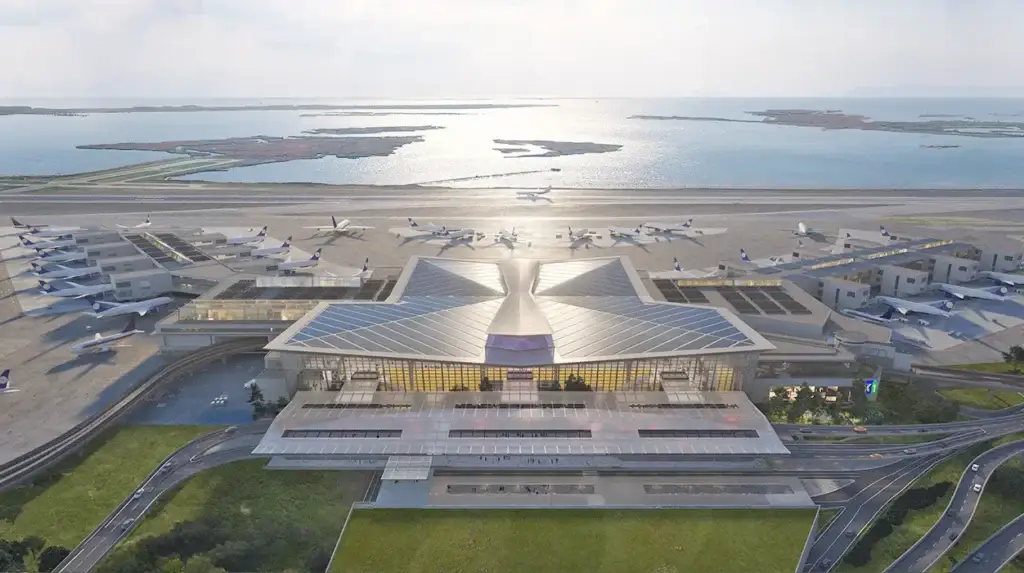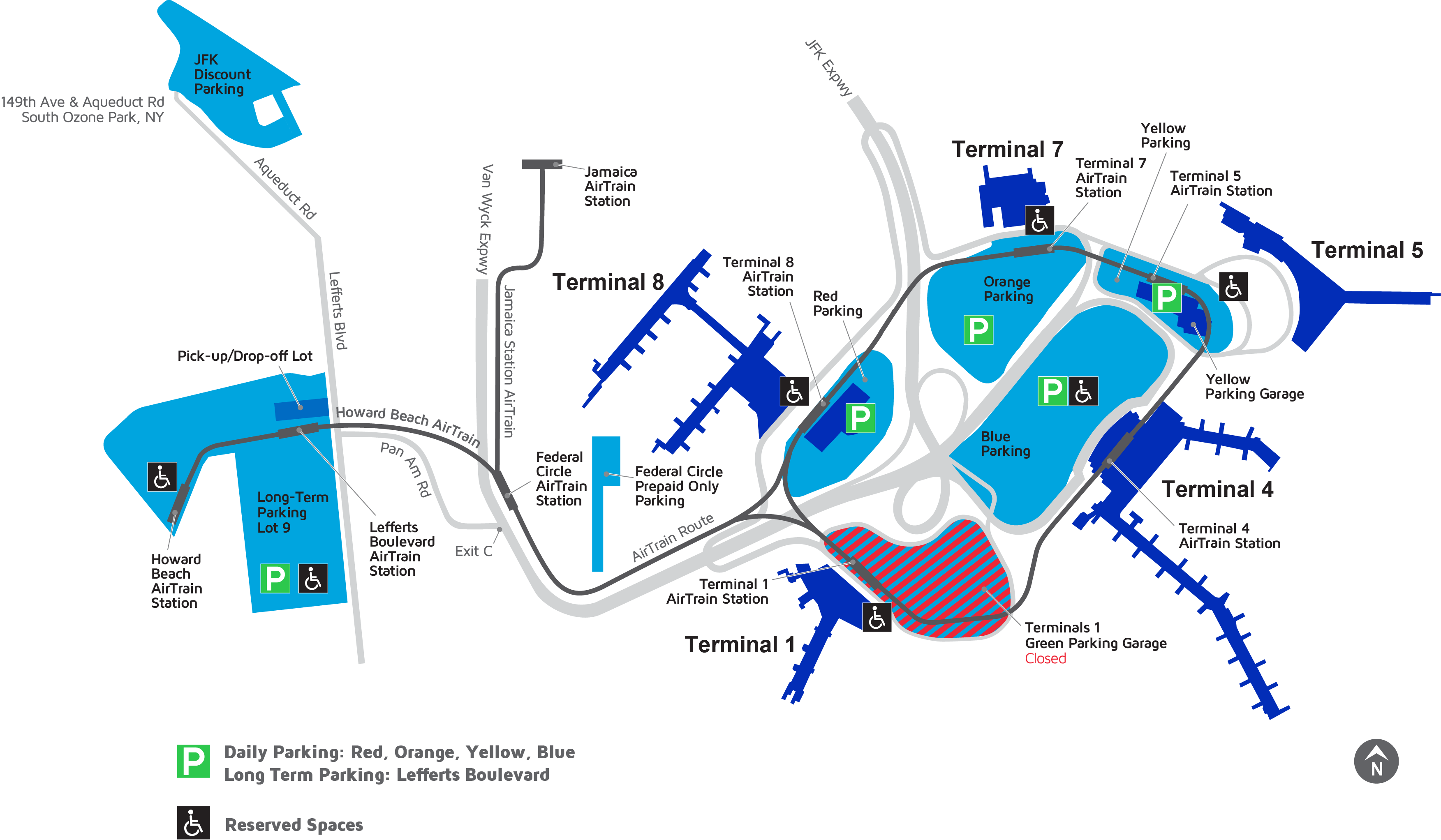John F. Kennedy International Airport (JFK) is a major airport in New York City. It serves as a hub for both domestic and international flights.
JFK Airport, located in Queens, New York, is one of the busiest airports in the United States. It handles millions of passengers each year, offering flights to destinations worldwide. The airport features six passenger terminals and offers a variety of amenities, including dining, shopping, and lounges.
Public transportation options like the AirTrain and numerous shuttle services make it accessible from various parts of the city. JFK also plays a crucial role in cargo operations, supporting global trade. With its extensive facilities and services, JFK remains a key gateway for travelers and goods entering and leaving the U. S.
History And Development of JFK Int. Airport
John F Kennedy International Airport, often referred to as JFK Airport, is one of the busiest airports in the United States. Its history and development reflect its importance in global aviation. This iconic airport has undergone significant changes since its inception, adapting to the evolving needs of air travel.
Origins Of The JFK Airport
JFK Airport began as Idlewild Airport in 1948. It was built to handle the increasing air traffic in New York City. The location was a former golf course, which provided ample space for runways and terminals.
The airport’s original design included six runways and a terminal complex. It aimed to accommodate the rapidly growing number of domestic and international flights. In its early years, Idlewild quickly became a major hub for transatlantic travel.
By the 1950s, the airport handled millions of passengers annually. It was clear that further development was necessary to keep up with the demand.
Expansion And Renaming of JFK Airport
In the 1960s, a major expansion project began. This included the construction of several new terminals and the extension of existing runways. The goal was to increase the airport’s capacity and improve passenger experience.
In 1963, the airport was renamed John F Kennedy International Airport in honor of the late President. This renaming marked a new era for the airport, emphasizing its importance on the world stage.
Throughout the 1970s and 1980s, JFK Airport continued to expand. New technologies and facilities were introduced to handle larger aircraft and more passengers. By the end of the 20th century, JFK had established itself as a leading international gateway.
Today, JFK Airport remains a critical hub for global travel. Its history and development showcase its resilience and adaptability in the ever-changing world of aviation.

Infrastructure And Facilities
John F Kennedy International Airport (JFK) is one of the busiest airports in the world. Its infrastructure and facilities are designed to handle millions of passengers annually. The airport offers a wide array of amenities and services, ensuring a seamless experience for travelers.
Terminals And Gates
JFK has six passenger terminals, numbered 1 through 8. Each terminal hosts a variety of airlines, making it easy for passengers to find their flights. The terminals are connected by the AirTrain, which provides free transportation between them. Terminal 4 is the largest, handling international flights and offering numerous gates for boarding.
Runways And Taxiways
The airport features four runways, ensuring efficient takeoffs and landings. The runways are well-maintained to accommodate different types of aircraft. Taxiways connect the runways to the terminals, enabling smooth movement of planes. This efficient layout minimizes delays and enhances safety.
Amenities And Services at JFK
JFK offers a range of amenities to enhance passenger comfort. Travelers can enjoy free Wi-Fi, lounges, and a variety of dining options. Car rental service counters are available in each terminal, providing easy access to vehicles. Shuttle service is available for convenient transfers, including routes from JFK to Manhattan. The airport also features numerous shops, ensuring that passengers can purchase essentials and souvenirs.
Airline Operations at JFK Airport
John F. Kennedy International Airport (JFK) is one of the busiest airports in the world. It serves as a major hub for both passenger and cargo airlines. The airport’s airline operations are extensive, ensuring smooth travel and efficient cargo handling.

Major Airlines
JFK hosts a wide range of major airlines. American Airlines, Delta Air Lines, and JetBlue Airways use JFK as a significant hub. These airlines offer numerous domestic and international flights daily.
Other major international airlines at JFK include British Airways, Emirates, and Lufthansa. These airlines connect New York City to key global destinations. The airport’s terminals are equipped with modern amenities to handle the high volume of passengers efficiently.
| Airline | Destination | Terminal |
|---|---|---|
| American Airlines | London | Terminal 8 |
| Delta Air Lines | Paris | Terminal 4 |
| JetBlue Airways | Los Angeles | Terminal 5 |
Cargo Operations
JFK is a crucial hub for cargo operations. The airport handles a significant portion of international air cargo traffic. FedEx, UPS, and DHL are key players in JFK’s cargo services. These companies use state-of-the-art facilities to manage high cargo volumes.
JFK’s cargo operations include the handling of perishable goods, pharmaceuticals, and high-value items. The airport has specialized cold storage and secure facilities to ensure safe handling. Cargo operations are vital for the economic activities of New York and beyond.
Passenger Experience
John F Kennedy International Airport (JFK) offers an exceptional passenger experience. This bustling hub provides a range of services to make your journey smooth and enjoyable. From efficient check-ins to delectable dining options, JFK has something for everyone.
Check-in And Security
Passengers at JFK experience a seamless check-in process. Self-service kiosks and mobile check-ins reduce wait times. Friendly staff assist with any issues, ensuring a hassle-free start to your trip.
Security is a breeze with advanced screening technology. TSA PreCheck lanes speed up the process, making it quicker and more convenient. Clear signage guides you through, so you won’t get lost.
Lounges And Dining
JFK boasts a variety of lounges for relaxation. Airline-specific lounges offer exclusive amenities. Priority Pass holders can access several stylish lounges with comfortable seating and free Wi-Fi.
Dining options are plentiful. You can enjoy gourmet meals or grab a quick bite. Local eateries and well-known chains offer diverse menus to satisfy any craving.
Shopping And Entertainment
The shopping experience at JFK is top-notch. Duty-free shops offer great deals on luxury items. Retail outlets feature the latest fashion, electronics, and travel essentials.
Entertainment options keep you engaged. Interactive kiosks provide information and fun facts about the airport. Art installations and live performances add a cultural touch to your wait time.
Community Impact
John F. Kennedy International Airport (JFK) is more than just a busy travel hub. It has a significant impact on the local community. From creating jobs to boosting the economy and caring for the environment, JFK plays a vital role in New York City and beyond.
Employment Opportunities
JFK provides a wide range of employment opportunities. The airport employs thousands of people in various roles. These include positions in security, customer service, baggage handling, and more. Local residents benefit from these jobs. They offer stable income and career growth. Businesses near the airport also create jobs. Hotels, restaurants, and retail stores hire many workers. This helps reduce unemployment in the area.
Economic Contribution
JFK’s economic contribution is immense. The airport generates billions of dollars each year. This money supports local businesses and services. Tourists spend money in hotels, restaurants, and shops. This boosts the local economy. JFK also attracts international businesses. Companies set up offices and warehouses nearby. This brings more money into the community. The airport’s operations require goods and services. Local suppliers benefit from these contracts. This creates a positive economic cycle.
Environmental Initiatives
JFK is committed to environmental initiatives. The airport has programs to reduce its carbon footprint. They use energy-efficient lighting and equipment. Renewable energy sources, like solar panels, are also in use. JFK promotes recycling and waste reduction. They encourage passengers to recycle and reduce plastic use. The airport also works to protect local wildlife. They create habitats and avoid disrupting natural areas. These efforts help make JFK a greener airport.

Challenges And Future Plans
John F Kennedy International Airport (JFK) is one of the busiest airports in the world. It faces numerous challenges as it strives to improve and expand. This section will explore the challenges and future plans of JFK Airport, focusing on traffic congestion, expansion projects, and technology integration.
Traffic Congestion
Traffic congestion is a significant issue at JFK Airport. Thousands of passengers travel from JFK to NYC and other destinations daily. The high volume of vehicles, including taxi and buses, contributes to the congestion. The airport’s infrastructure struggles to handle the traffic efficiently, causing delays and frustration for travelers.
To alleviate this problem, authorities are working on better traffic management strategies. These include improving roadways and optimizing traffic signals. Additionally, efforts to enhance public transportation options aim to reduce the number of private vehicles on the roads. Improved shuttle services between JFK and nearby airports like LaGuardia and Newark (EWR) are also being considered.
Expansion Projects
Expansion projects at JFK are essential to accommodate the growing number of passengers. The airport plans to upgrade existing terminals and construct new ones. These projects aim to increase capacity and provide better services.
One of the significant expansion plans includes the construction of a new terminal, which will feature modern amenities and more gates. This will help reduce wait times and improve the overall passenger experience. The expansion also includes enhancements to the airport’s parking facilities, making it easier for travelers to find parking spaces.
Here is a table summarizing the major expansion projects:
| Project | Details | Completion Date |
|---|---|---|
| New Terminal | Modern amenities, additional gates | 2025 |
| Parking Facilities Upgrade | More parking spaces, improved access | 2023 |
Technology Integration
Technology integration is a crucial aspect of JFK’s future plans. The airport aims to enhance passenger experience through advanced technology. This includes implementing automated check-in kiosks and biometric security systems. These technologies will help speed up processes and reduce wait times.
JFK Airport also plans to introduce more efficient baggage handling systems. This will ensure that luggage is processed quickly and accurately. Additionally, improved communication systems will provide real-time updates to passengers, keeping them informed about their flights and any potential delays.
By embracing technology, JFK Airport aims to become a more efficient and passenger-friendly hub. These advancements will not only improve the overall travel experience but also help the airport manage the increasing number of travelers more effectively.
Notable Events And Incidents
John F Kennedy International Airport, often known as JFK, is one of the busiest airports in the world. It has a rich history filled with notable events and incidents. These moments have shaped its legacy and impact on global travel.
Historical Milestones
JFK opened in 1948 as Idlewild Airport, named after the Idlewild Golf Course it replaced. In 1963, it was renamed to honor President John F. Kennedy after his assassination. The airport saw its first transatlantic jet service in 1958, marking the beginning of the jet age.
In 1977, the airport introduced its iconic Terminal 4, which became a major hub for international flights. The terminal expanded multiple times to accommodate growing passenger numbers. In 2001, the AirTrain JFK opened, providing a crucial connection to the New York City subway system.
Security Breaches And Accidents
JFK has experienced several security breaches and accidents over the years. In 1996, TWA Flight 800 tragically crashed shortly after takeoff, resulting in the loss of all 230 passengers and crew. The incident led to significant changes in aviation safety protocols.
In 2016, a major security breach occurred when an armed man bypassed security and boarded a plane. This incident prompted a reevaluation of security measures at the airport. There have also been minor accidents, including runway incursions and minor aircraft collisions.
Famous Landmarks Nearby
John F Kennedy International Airport (JFK) is not just a gateway to New York City but also to some of the world’s most iconic landmarks. Whether you’re here for a layover or starting your NYC adventure, there are plenty of famous attractions nearby that are worth exploring. Below are some of the must-see landmarks easily accessible from JFK.
Statue Of Liberty
The Statue of Liberty stands tall as a symbol of freedom and democracy. Located on Liberty Island, this colossal statue is a gift from France to the United States. From JFK, you can easily reach the Statue of Liberty by taking a combination of subway and ferry rides. The view from the crown is breathtaking and offers a panoramic perspective of New York Harbor.
Empire State Building
The Empire State Building is another iconic landmark you shouldn’t miss. This 102-story skyscraper in Midtown Manhattan offers stunning views of the city from its observatories on the 86th and 102nd floors. You can get there from JFK by taking the AirTrain and then transferring to the subway. The building is also close to other attractions like the New York Hall of Science and the Queens Botanical Garden, making it a perfect spot for a day trip.
Central Park
Central Park is an urban oasis in the heart of New York City. Spanning over 843 acres, the park offers a variety of activities such as boating, picnicking, and exploring the Central Park Zoo. From JFK, you can reach Central Park by taking public transportation. The park is also near other points of interest like the Jamaica Bay Wildlife Refuge and Rockaway Beach, providing more opportunities for outdoor fun.
Frequently Asked Questions
What Is Jfk Airport Called Now?
JFK Airport is now officially called John F. Kennedy International Airport. It is commonly known as JFK.
Where Was John F Kennedy Airport?
John F. Kennedy Airport is in Queens, New York City. It serves as a major international gateway.
What Did The Jfk Airport Used To Be Called?
JFK Airport was originally called Idlewild Airport. It was renamed in 1963 to honor President John F. Kennedy.
Why Was It Called Idlewild Airport?
Idlewild Airport was named after the Idlewild Beach Golf Course it replaced. The airport opened in 1948.
What Is Jfk Airport’s Iata Code?
JFK Airport’s IATA code is JFK, representing John F. Kennedy International Airport.
How Many Terminals Does Jfk Have?
JFK Airport has six terminals, each serving various airlines and destinations.
Where Is Jfk Airport Located?
JFK Airport is in Queens, New York City, approximately 15 miles from Manhattan.
How To Get To Jfk From Manhattan?
You can take a taxi, shuttle, subway, or AirTrain to reach JFK from Manhattan.
What Airlines Operate At Jfk Airport?
Major airlines like Delta, American Airlines, JetBlue, and international carriers operate at JFK Airport.
Does Jfk Airport Have Free Wi-fi?
Yes, JFK Airport offers free Wi-Fi in all terminals for passengers.
Conclusion
John F Kennedy International Airport stands as a gateway to countless destinations. It offers travelers modern amenities and efficient services. Whether you’re flying for business or pleasure, JFK ensures a seamless experience. Discover the convenience and excellence of this iconic airport on your next journey.
Safe travels!

